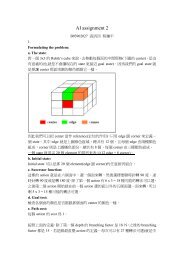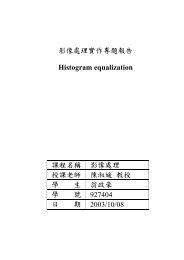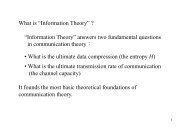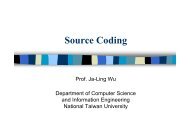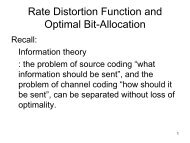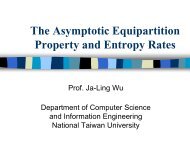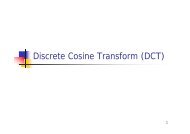Motion Estimation for Video Coding Standards
Motion Estimation for Video Coding Standards
Motion Estimation for Video Coding Standards
You also want an ePaper? Increase the reach of your titles
YUMPU automatically turns print PDFs into web optimized ePapers that Google loves.
<strong>Motion</strong> <strong>Estimation</strong> <strong>for</strong><br />
<strong>Video</strong> <strong>Coding</strong> <strong>Standards</strong><br />
Prof. Ja-Ling Wu<br />
Department of Computer Science and In<strong>for</strong>mation Engineering<br />
National Taiwan University
Introduction of <strong>Motion</strong> <strong>Estimation</strong><br />
• The goal of video compression is to reduce the<br />
total transmission bit rate <strong>for</strong> reconstructing images<br />
at the receiver.<br />
Stationary Camera<br />
Non-Stationary Camera<br />
Scaled Frame Difference<br />
Scaled Frame Difference
Introduction of <strong>Motion</strong> <strong>Estimation</strong><br />
• Hence, we encode the motion in<strong>for</strong>mation which<br />
occupies only a small amount of the trans<strong>for</strong>mation<br />
bandwidth additional to the picture content in<strong>for</strong>mation.<br />
• <strong>Motion</strong> estimation techniques are also used in many<br />
other applications:<br />
– Computer vision, target tracking, industrial<br />
monitoring<br />
• <strong>Motion</strong> estimation techniques can be roughly<br />
classified into three groups:<br />
– Block matching groups<br />
– Differential (Gradient) methods<br />
– Fourier Methods
Introduction of <strong>Motion</strong> <strong>Estimation</strong><br />
• In the physical world, objects are moving in the 4-D<br />
spatio-temporal domain (three spatial coordinates and<br />
one temporal domain). However, image video taken by<br />
a single camera is a 3-D cube (2D projections of 3-D<br />
spatial objects along time axis).<br />
• In reality, videos taken by an ordinary camera is first<br />
sampled along the temporal axis. Typically, the<br />
temporal sampling rate (frame rate) is 24.25 or 29.97<br />
frames/sec. Spatially, every frame is sampled vertically<br />
into a number of horizontal lines, and a line is sampled<br />
into a number of pels.<br />
e.g. 240x352 pels
Introduction of <strong>Motion</strong> <strong>Estimation</strong><br />
• <strong>Motion</strong>-compensated estimation is an effective<br />
means in reducing the inter-frame correlation <strong>for</strong><br />
image sequence coding. It is the operation of<br />
predicting an image (or portion thereof) based on<br />
displacement of a previously transmitted frame in<br />
an image sequence.<br />
• By motion estimation, we mean the estimation of<br />
displacement (or velocity) of image structures from<br />
one frame to another in a time-sequence of 2-D<br />
images.
Introduction of <strong>Motion</strong> <strong>Estimation</strong><br />
• To reduce computation and storage complexity,<br />
motion parameters of objects in a picture are<br />
estimated based on two or three nearby frames.<br />
• General assumptions:<br />
(i) Objects are rigid bodies; hence, object de<strong>for</strong>mation can be neglected<br />
<strong>for</strong> at least a few nearby frames.<br />
(ii) Objects move only in translation movement <strong>for</strong> at least a few frames.<br />
(iii) Illumination is unchanged under movement.<br />
(iv) Occlusion of one object by another and uncovered background are<br />
neglected.
Definition of Moving Object<br />
• Moving object:<br />
– A group of contiguous pels that share the same set of motion<br />
parameters. It does not necessarily match the ordinary<br />
meaning of the object. For example, still background can be<br />
considered as a single object.<br />
• The effect of object size:<br />
– Small objects (or evaluation windows)<br />
• Ambiguity problem : Similar objects (image patterns) may appear at<br />
multiple locations inside a picture and may lead to incorrect displacement<br />
vectors.<br />
• Noise sensitivity problem : Statistically, estimation based on a small set of<br />
data are more vulnerable to random noise than those based on a large set<br />
of data.<br />
– Large objects (or evaluation windows)<br />
• Accuracy problem : Pels inside an object or evaluation window do not<br />
share the same motion parameters and, there<strong>for</strong>e, the estimated motion<br />
parameters are not accurate <strong>for</strong> some or all pels in it.
Definition of Moving Object<br />
• Practical solution to determine object size:<br />
– Partition images into regular, non-overlapped blocks; assuming<br />
that moving objects can be approximated reasonably well by<br />
regular shaped blocks. Then, a single displacement vector is<br />
estimated <strong>for</strong> the entire image block under the assumption that<br />
all the pels in the block share the same displacement vector.<br />
– The above assumption may not always be true because an<br />
image block may contain more than one moving object. In<br />
image sequence coding, however, prediction errors due to<br />
imperfect motion compensation are coded and transmitted.<br />
– The block-based motion estimation approach is adopted by the<br />
video coding standards <strong>for</strong> partially, at least, its robustness as<br />
compared to pel-based approach.
Definition of Moving Object<br />
• Practical solution to determine object size:<br />
– Partition images into regular, non-overlapped blocks; assuming<br />
that moving objects can be approximated reasonably well by<br />
regular shaped blocks. Then, a single displacement vector is<br />
estimated <strong>for</strong> the entire image block under the assumption that<br />
all the pels in the block share the same displacement vector.<br />
– The above assumption may not always be true because an<br />
image block may contain more than one moving object. In<br />
image sequence coding, however, prediction errors due to<br />
imperfect motion compensation are coded and transmitted.<br />
– The block-based motion estimation approach is adopted by the<br />
video coding standards <strong>for</strong> partially, at least, its robustness as<br />
compared to pel-based approach.
<strong>Motion</strong>-compensated <strong>Coding</strong> Structure<br />
• <strong>Motion</strong> compensation:<br />
(1) Access the previous-frame image data according to the estimated<br />
displacement vector.<br />
(2) Construct the predicted pels by passing the previous-frame image<br />
through the prediction filter.
<strong>Motion</strong>-compensated <strong>Coding</strong> Structure<br />
• H.261/263: I, P<br />
• MPEG-1/2: I,P,B Encoding/transmission order<br />
• A picture frame in MPEG-2 may contain two interleaved<br />
fields:<br />
– Frame-based motion compensation<br />
– Field-based motion compensation
<strong>Motion</strong>-compensated <strong>Coding</strong> Structure<br />
• As long as the motion parameters we obtain can<br />
efficiently reduce the total bit rate, these parameters<br />
need not to be the true motion parameters.<br />
• If the reconstructed images are used <strong>for</strong> estimating<br />
another motion in<strong>for</strong>mation, a rather strong noise<br />
component can not be neglected. Drift Problem<br />
• Notice that the current video standards specify only the<br />
decoder, i.e. the encoder which per<strong>for</strong>ms the motion<br />
estimation operation is not explicitly specified in the<br />
standards, a great amount of flexibility exists in<br />
choosing and designing a motion estimation scheme <strong>for</strong><br />
a standard coder.
Block Matching Method<br />
• Block matching is a correlation technique that<br />
searches <strong>for</strong> the best match between the current<br />
image block and candidates in a confined area of the<br />
previous frame.<br />
– Goal:<br />
• Reduce the computational load in calculating the motion vector.<br />
• Increase the motion vector accuracy.<br />
– Jain& Jain, “Displacement measurement and its application in<br />
interframe coding,” IEEE Trans. Communications, vol. COM-29,<br />
pp. 1799-1809, Dec. 1981.
Block Matching Method
Block Matching Method<br />
• The size of the block affects the per<strong>for</strong>mance of<br />
motion estimation.<br />
– Small block sizes af<strong>for</strong>d good approximation to the natural object<br />
boundaries; they also provide good approximation to real motion.<br />
However, small block sizes produce a large amount of raw<br />
motion in<strong>for</strong>mation, which increases the number of transmission<br />
bits or the required data compression complexity to condense<br />
this in<strong>for</strong>mation. Small blocks also suffer from object (block)<br />
ambiguity problem and the random noise problem.<br />
– Large block sizes may produce less accurate motion vectors,<br />
since a large block may likely contain pels moving at different<br />
speeds and directions.<br />
– 8x8, 16x16 in H.261, MPEG-1, MPEG2
Block Matching Method<br />
• The basic operation of block matching is picking up a<br />
candidate and calculating the matching function<br />
(usually a nonnegative function of the intensity<br />
difference) between the candidate and the current<br />
block.<br />
• This basic operation is repeated until all the<br />
candidates have gone through and then the best<br />
matches candidate is identified. The location of the<br />
best matched candidate <strong>for</strong>ms the estimated<br />
displacement vector.<br />
• Important parameters:<br />
– the number of candidate blocks (search points)<br />
– the matching function<br />
– the search order of candidates
Block Matching Method
Matching Function<br />
• The selection of the matching function has a direct impact on<br />
computational complexity and the displacement vector accuracy.<br />
• Let (d 1,d 2) represent a motion vector candidate inside the search<br />
region and f(n 1,n 2,t) be the digitalized image intensity at the<br />
integer-valued 2-D image coordinate (n 1,n 2) at the t-th frame.<br />
– Normalized cross-correlation function (NCF):<br />
– Mean square error (MSE)<br />
– Mean absolute difference (MAD):<br />
– Number of threshold difference(NTD)<br />
=
• Remarks:<br />
Matching Function<br />
– To estimate the motion vector, we normally maximize the value of<br />
NCF or minimize the values of the other three functions.<br />
– In detection theory, if the total noise (a combination of coding<br />
error and the other factors violating our motion assumptions) can<br />
be modeled as white Gaussian, then the NCF is the optimal<br />
matching criterion. However, the white Gaussian assumption is<br />
not completely valid <strong>for</strong> real images. In addition, the computation<br />
requirement of NCF is enormous. The other matching<br />
functions are regarded as more practical, and they per<strong>for</strong>m<br />
almost equally well <strong>for</strong> real images.<br />
– NTD can be adjusted to match the subjective thresholding<br />
characteristics of the human visual system.<br />
– MAD is the most popular choice in designing pratical image<br />
coding systems because of its good per<strong>for</strong>mance and relatively<br />
simple hardware structure.
• Basic Principle:<br />
Fast Search Algorithms<br />
– Breaking up the search process into a few sequential steps and<br />
choosing the next-step search direction based on the current–<br />
step result.<br />
– At each step, only a small number of search points are calculated.<br />
There<strong>for</strong>e, the total number of search points is significantly<br />
reduced.<br />
– Since the steps are per<strong>for</strong>med in sequential order, and incorrect<br />
initial search direction may lead to a less favorable result. Also,<br />
the sequential search order poses a constraint on available<br />
parallel processing structure.
Fast Search Algorithms<br />
• Normally, a fast search algorithm starts with a rough search,<br />
computing a set of scattered search points. The distance<br />
between two nearby search points is called search step size.<br />
• After the current step is completed, it then moves to the<br />
most promising search points and does another search with<br />
probably a smaller step size.<br />
Simulated Annealing,<br />
Genetic Algorithm,<br />
Neural Networks,<br />
Support Vector Machine
Fast Search Algorithms<br />
• If the matching function is “monotonic” along any direction<br />
away from the optimal point, a well designed fast algorithm<br />
can then be guaranteed to converge to the global optimal<br />
point. But in reality the image signal is not a simple Markov<br />
process and it contains coding and measurement noises;<br />
there<strong>for</strong>e, the monotonic matching function assumption is<br />
often not valid and consequently fast search algorithms are<br />
often suboptimal.<br />
possible next step
2-D-log Search Procedure<br />
• Diamond-shaped search area (at most 5-points per step)<br />
• 9 search points in 3x3 area surrounding the last best<br />
matching point are compared.<br />
• The step size is reduced to half of its current value if the best<br />
match is located at the center or located on the border of the<br />
maximum search region.
3-step Search Procedure<br />
• The search starts with a step size equal to or slightly larger<br />
than half of the max search range.<br />
• 9-points are compared in each step.<br />
• The step size is reduced by half, after each step, and the<br />
search ends with step size of 1 pel.
• Remarks:<br />
Fast Search Algorithms<br />
– A threshold function is used to terminate the search process<br />
without reaching the final step. As long as the matching error is<br />
less than a small threshold, the resultant motion vector would be<br />
acceptable.<br />
– One-at-a-time search: Separate a 2-D search problem into two 1-<br />
D problems. That is, look <strong>for</strong> the best matching point in one<br />
direction first, and then looks in the other direction.
• Remarks:<br />
Fast Search Algorithms<br />
– In hardware systems, the exhaustive search and the 3-step<br />
search are often favored <strong>for</strong> their good PSNR per<strong>for</strong>mance, their<br />
fixed and fewer number of search steps and their identical<br />
operation in every step.
Variants of Block Matching Algorithms<br />
• The computation load could also be reduced by calculating<br />
fewer blocks of an image.<br />
– To increase search efficiency, we could place the initial search point at a<br />
location predicted from motion vectors of the spatially or the temporally<br />
adjacent blocks. A best matching can often be obtained by searching a<br />
smaller region surrounding this initial point.<br />
– We could first separate the moving image blocks from the stationary<br />
ones and then conduct block matching only on the moving objects. This<br />
is because a moving or change detector can be implemented with much<br />
fewer calculations than a motion etimator.<br />
– We could use only a portion of the pels inside an image block<br />
(subsampled images) to calculate the matching function. However, the<br />
accuracy of motion might be reduced.<br />
– Per<strong>for</strong>m the motion estimation only on alternate blocks in an image, and<br />
the motion vectors of the missing blocks are “interpolated” from the<br />
calculated motion vectors.
Variants of Block Matching Algorithms<br />
• Basic principle:<br />
– A large block size is chosen at the beginning to obtain a rough<br />
estimation of the motion vector. Because a large-size image pattern is<br />
used in matching. The ambiguity problem-blocks of similar content can<br />
often be eliminated. However, motion vectors estimated <strong>for</strong>m large<br />
blocks are not accurate. We then refine the estimated motion vector by<br />
decreasing the block size and the search region.<br />
– A new search with a smaller block size starts from an initial motion<br />
vector that is the best matched motion vector in the previous stage.<br />
Because pels in a small block are more likely to share the same motion<br />
vector, the reduction of block size typically increases the motion vector<br />
accuracy.
Variants of Block Matching Algorithms<br />
• Variable-block-size motion estimation:<br />
– Image frames are partitioned into non-overlapped large image<br />
blocks. If the motion-compensated estimation error is higher than<br />
a threshold, this large block is not well compensated; there<strong>for</strong>e, it<br />
is further partitioned into, say, four smaller blocks.
1st<br />
4th 16th 112th<br />
256th<br />
2nd<br />
Original Image<br />
3rd





